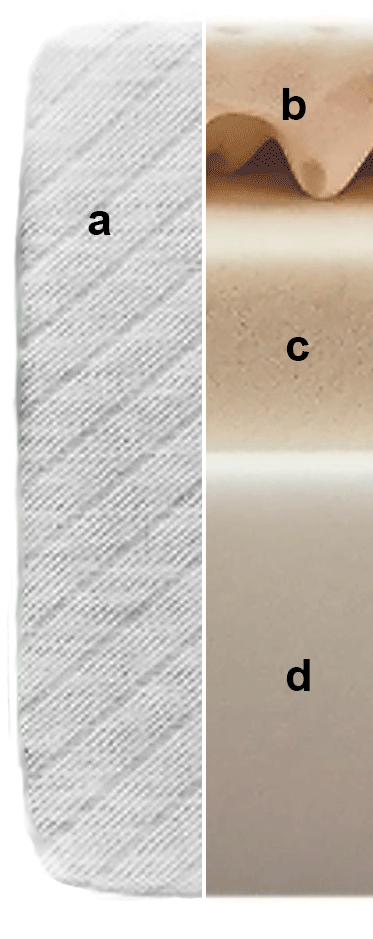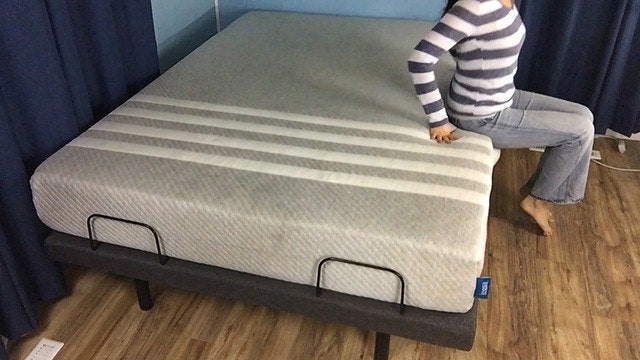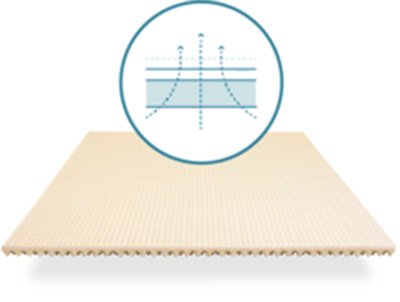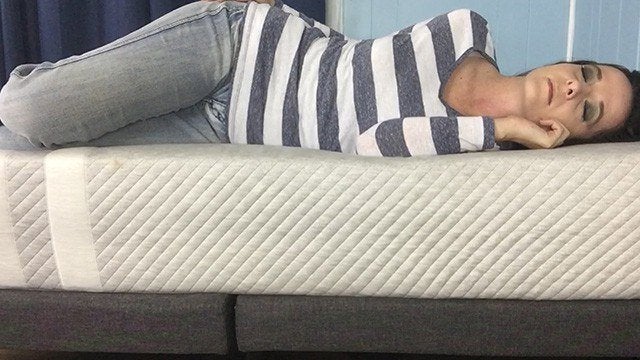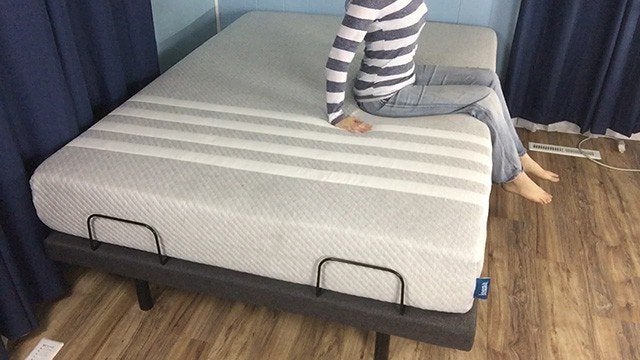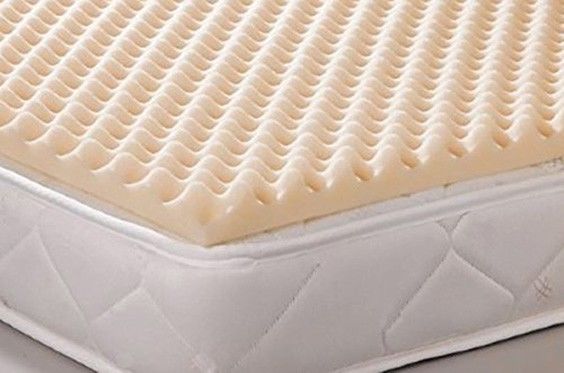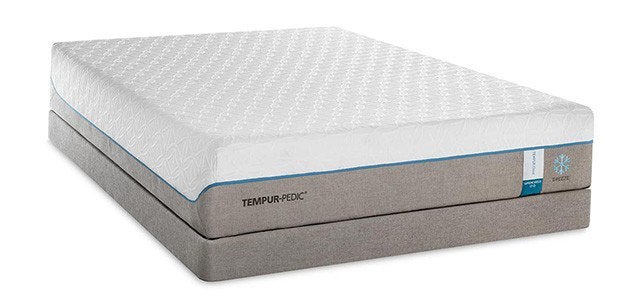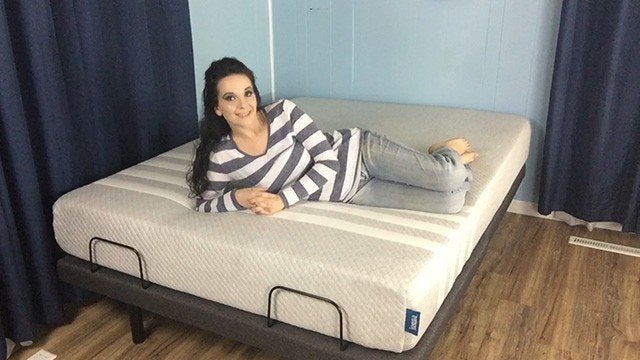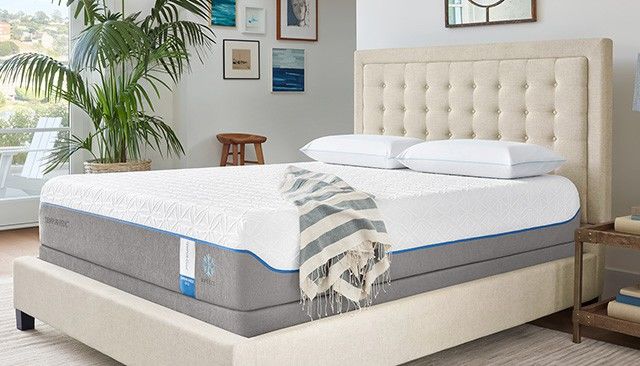Leesa is a new-age online-only mattress brand that has shaken up some feathers by providing a highly luxurious all-foam product to consumers who previously had to spend hundreds (and in some cases, thousands) more on established brands that charged a premium just for their names.
Given that Leesa is a very junior company, though, it is only logical to be skeptical about its claims of personalized comfort and support, especially when compared to venerable brands such as Tempurpedic. So here’s my Leesa vs Tempurpedic comparison to shed some light on how the Leesa fares against a tried-and-tested mattress brand.
Leesa Mattress
Construction
The Leesa has an all-foam, 3-layered 10” construction:
a. Cover
The Leesa’s 3 foam layers are encased in a fabric cover that’s woven almost seamlessly. It is soft, smooth and very well-made, quite suitable for a luxury product.
b. Comfort Layer
This layer is made out of 2” of Avena® foam which the company uses under license from Carpenter Co. This foam artificially imitates the qualities of natural latex, yielding bounce, heat dissipation, and responsiveness, while also being more durable!
c. Middle Layer
2” of viscoelastic foam make up the transitional layer; it is responsible for providing adaptive support, resulting in optimal spinal alignment. By placing it below the Avena® layer, the manufacturer attempts to reduce the heat retention issue associated with viscoelastic.
d. Support Layer
The base layer is made from 6” of 1.8 lbs /cu ft polyurethane foam that supports the entirety of your weight as you sleep on the mattress through the night.
Firmness and Feel
Comfort and Support
The predominant feel of Leesa is medium-firm since it aims to be a unifying solution that suits the wide majority of sleepers. The combination of Avena® foam’s bouncy latex-like comfort with the contouring and adaptive nature of the intermediate memory foam layer helps it achieve an initial feel that is both cushioning and responsive.
The 6” HD polyfoam base layer, on the other hand, manages to create enough support to comfortably sustain all major sleeping styles without excessive sinkage – in fact, it can even handle this for heavier individuals.
Edge Support
The bounciness of the topmost foam layer counters some of the sinking plushness of the underlying memory foam layer, which translates into better edge support than what you’d expect from a typical viscoelastic product.
Cooling
The Leesa is able to achieve a decent degree of cooling (for a mattress that uses memory foam) thanks to the convoluted construction of Avena® foam which gives it superior airflow properties so that it takes the heat away from your body faster than ordinary memory foam would.
Leesa Mattress Air Flows
Unique Features
Combination of bounce and contouring
Most mattresses that incorporate memory foam try to sell themselves on the basis of plushness, conformity, or cradling alone: some people are fans of this kind of support (side sleepers and lightweight individuals, for instance), but there are others who prefer some push-back and resilience in their bed.
The Leesa combines the latex-like bounciness of Avena® foam with the traditional contouring feel of viscoelastic in an attempt to please both camps, and it is quite successful at it for normal weight individuals.
One universal choice for no-fuss buyers
If you can’t be bothered to do lots of homework to determine a foam material that is best suited specifically to you, the Leesa is a considerably safe bet due to its blend of conformity and bounce which lends itself to virtually all sleep preferences.
Tempurpedic Mattress
Tempurpedic’s TEMPUR-Breeze series is its flagship mattress line, incorporating their latest innovations in viscoelastic technology to create cool, adaptive, and personalized comfort and support. While there are indeed 7 different models, ranging from soft to firm, it makes sense to compare the Leesa with the one which is most close to its level of firmness, and that is the medium Cloud Supreme Breeze.
Construction
The TEMPUR Cloud Supreme Breeze is also an all-foam mattress that is made of four different layers of foam with a net height of 11.5 inches, encased in a polyester/spandex cover.
a. Cover
The cover, as expected for a high-end product, is soft with an aesthetically appealing traditional pattern. The detachable top of the cover is made from Tempurpedic’s proprietary Breeze fabric that yields a cool-to-the-touch surface feel.
b. Comfort Layer
The topmost layer is made from 2 inches of memory foam, and it is intended to yield a soft initial feel with the cradling sensation that is the hallmark of the Tempurpedic brand.
c. Second Layer
This layer serves as a transition between the comfort layer and the two lower support layers, and it is made from slightly firmer memory foam which brings in an element of supportiveness, in addition to the usual cushioning expected from viscoelastic.
d. Third Layer
The upper support layer is made from 4” of convoluted polyurethane foam that supports your weight and adds a bit of pushback so that you don’t sink all the way through.
e. Fourth Layer
The last layer, comprising of 3.5 inches of convoluted polyurethane foam, ensures deep support and optimum spinal alignment, thanks to its denser composition.
Firmness and Feel
Comfort and Support
Being a viscoelastic mattress, you can expect the Cloud Supreme to have a considerable degree of sinkage – as much as 3-inches for a normal-weighted individual once they lay on it for a long enough time. Consequently, the support it provides is highly adaptive, pressure-relieving, and cradling, which is perfectly in line with memory foam products.
Keep in mind that the softness may lead to excessive sinkage if you’re a bulky individual who likes to sleep on their stomach or back. You may feel this in these sleeping positions even if you’re normal weight but close to the overweight threshold.
That said, if you don’t have any issues with this kind of ‘hugging’ action, the support layers of the mattress do their job nicely, and it even prevents any further sinking, ensuring that your body is generally well supported. Furthermore, this mattress yields dead support i.e. there is absolutely no motion transfer.
Edge Support
This being a “typical” memory foam mattress, it would be unwise to expect decent edge support. I’ve already discussed the kind of sinking you get with the Cloud Supreme – and that is the major culprit behind the dearth of support around the edges.
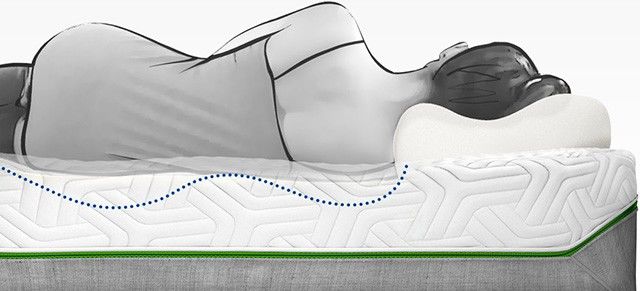
Cooling
The Supreme Breeze uses TEMPUR-Breeze material inside its cover fabric to actively transport heat away from your body as you sleep. The convoluted, egg-crate-like construction of the lower support layers also ensures ample airflow which assists in cooling down the viscoelastic upper layers.
While Tempurpedic mattresses have received quite a few complaints about heat retention, complaints about this particular model have been in the minority which could imply that the cooling mechanism is working as intended here.
However, I do have reservations about the excessive sinkage that could cause heavier individuals to be ‘enveloped’ by the memory foam. In turn, they experience greater heat retention than normal weighted consumers.
Unique Features
More options
Although I’ve focused on the Cloud Supreme Breeze model, in particular, it is only fair to mention that there are six other variants in the Tempurpedic line with varying degrees of firmness that would suit you better. If you’ve got specific sleep needs that can only be addressed by a particular firmness level (e.g. are overweight/underweight and sleep with an awkward posture), this gives Tempurpedic an edge over Leesa.
Extreme contouring and pressure relief
The dual viscoelastic upper layers mold themselves to the shape of your body and more so where the weight of your body is concentrated. This prevents the development of pressure points that can compromise the quality of your sleep, particularly, if you have an unorthodox sleeping style.
Detachable cover
The upper part of the mattress’ cover can be removed for cleaning (manufacturer recommends only spot cleaning, by the way) – this could be a potentially important factor if you’ve got pets or kids in the house (always a good idea to have a decent mattress protector in the way!).
Which One to Get
Leesa
Get the Leesa if:
You don’t have specific sleep requirements: If you’re one of those people who sleep on their back one night and on their side on another (and sometimes even on your stomach), the Leesa with its balance of support and conformity will service your needs well.
You share the bed with a partner: Partners can have quite different sleeping habits, and if that’s the case with you, the Leesa is a safe bet with its moderate feel.
You like a responsive bed: Because of the latex-like Avena® foam used in its comfort layer, the Leesa exhibits bounciness that nullifies some of the deadness resulting from its use of memory foam.
You want to know exactly what you’re getting into: Leesa clearly specifies the densities and IFD values for the foam materials it uses in its mattress, leaving it up to you to decide its suitability for your needs – a major turn on for sleep geeks such as yours truly.
You want the best bang for the buck: The Tempurpedic costs literally thousands more than the Leesa while offering comparable performance. If you’re willing to look past brand recognition and are OK with a bit of bounce in your bed, the Leesa definitely has more value for the money.
You want a more generous sleep trial: Leesa comes with a 100-night sleep trial with a money back guarantee (compare this with Tempurpedic’s 90-day trial). It is quite clear which product represents the safer bet if you’re not sure about whether you need a viscoelastic hybrid mattress or not.
Tempurpedic
Go for a Tempurpedic mattress if:
You’re particular about your sleep requirements: By offering 7 different firmness variants to choose, the Tempurpedic lineup definitely offers more to those who want a mattress that is inline with their sleep style.
You crave the typical pressure relieving, cushioning feel of memory foam: There’s no debate here that the two upper memory foam layers found in the Tempurpedic result in a thoroughly plush, cradling, and pressure relieving support.
You have an unusual sleep posture: Sleeping in an awkward position, e.g. on your side, can put extra stress on your spine. The conforming nature of Tempur’s comfort layers counters this stress, ensuring optimal spinal alignment for stress-free sleep.
You want a more established brand: Tempurpedic has been around for decades, while Leesa only launched a few years ago. The venerability of the Tempur’s name is therefore unquestionable and is backed by millions of sold units and thousands upon thousands of satisfied customers. Naturally, they charge a lot of money for the brand name alone.
Leesa vs Tempurpedic Comparison
| Leesa | Tempurpedic | |
|---|---|---|
| Layers Used | Avena® Foam 2” / 3.6 lbs. / 20 IFD; Memory Foam 2” / 3.0 lbs / 2 IFD; Base Foam 6” / 1.8 lbs / 32 IFD |
2” Memory Foam; 2” Memory Foam; 4” Polyurethane Foam; 3.5” Polyurethane Foam |
| Height | 10 inches | 11.5 inches |
| Firmness | Medium Firm | Medium |
| Motion Transfer | Small | None |
| Breathability | Slightly below average | Slightly below average |
| Trial Period | 100-nights | 90-days |
| Warranty | 10-years | 10-years |
| Pricing (Queen) | $940 | $3,599 |
| Shipping | Free | Free |
Let’s Hear Your Thoughts!
I hope you enjoyed (and found it helpful!) this comparison between Leesa and Tempurpedic – do leave your queries and suggestions in the comment section. Also, feel free to share this post with friends and family who are looking to buy a high-end all-foam mattress.
Want more comparison reviews? Check out our Leesa vs Casper review.
